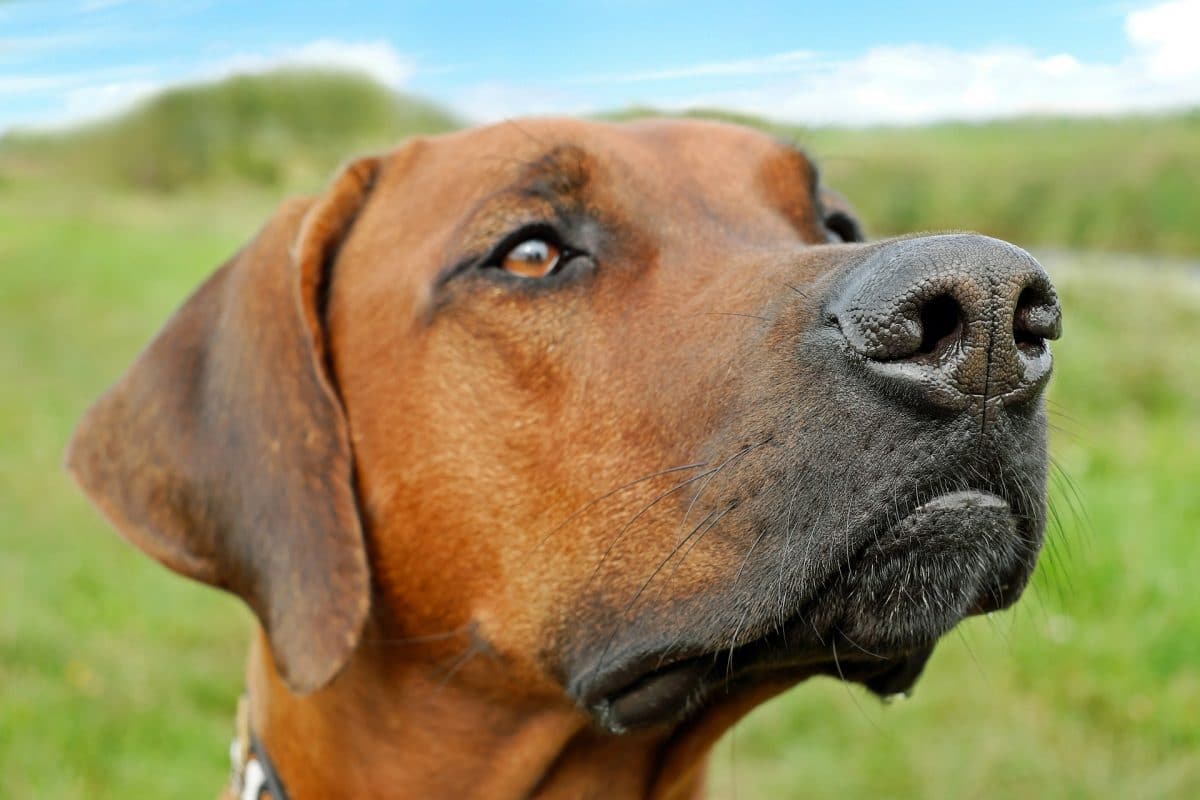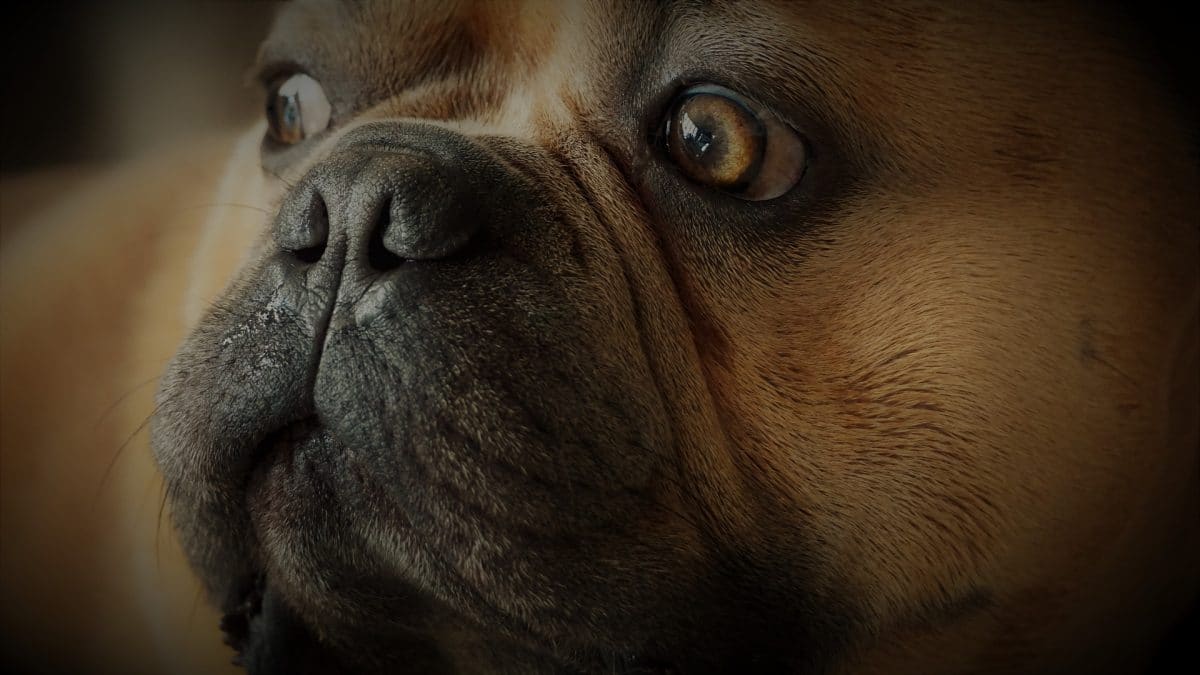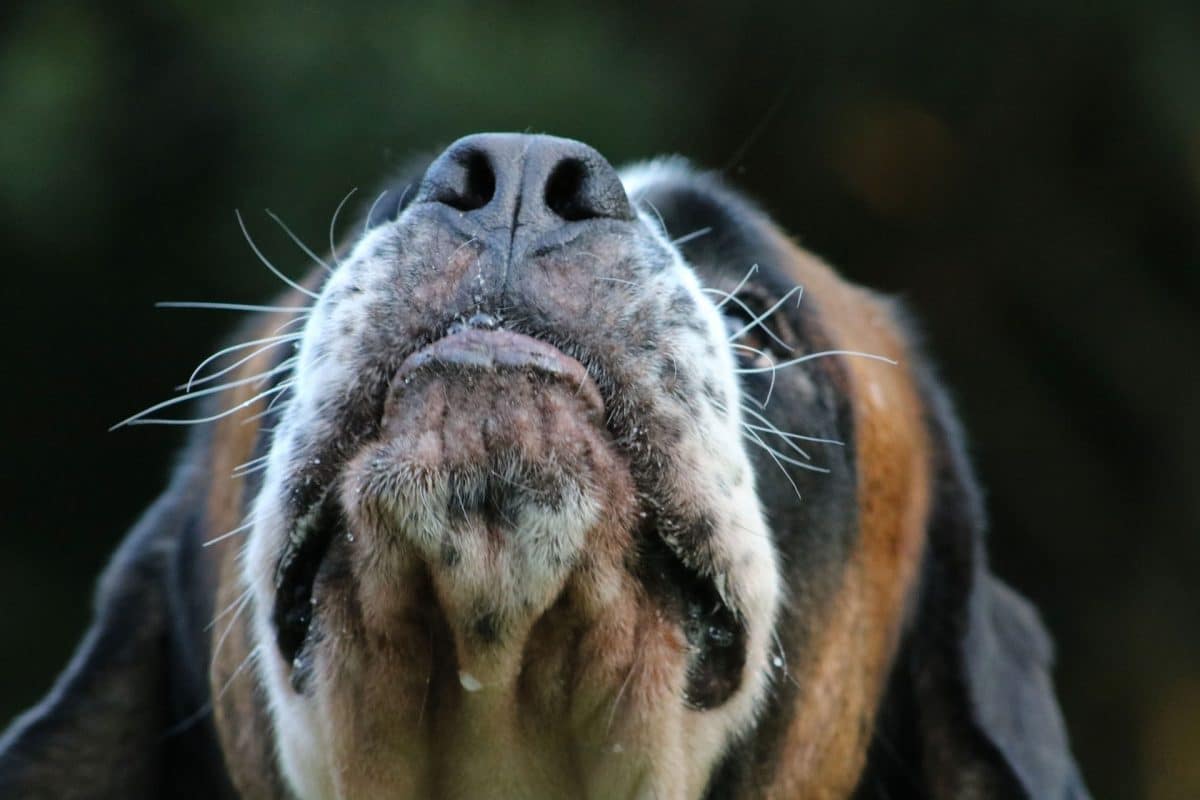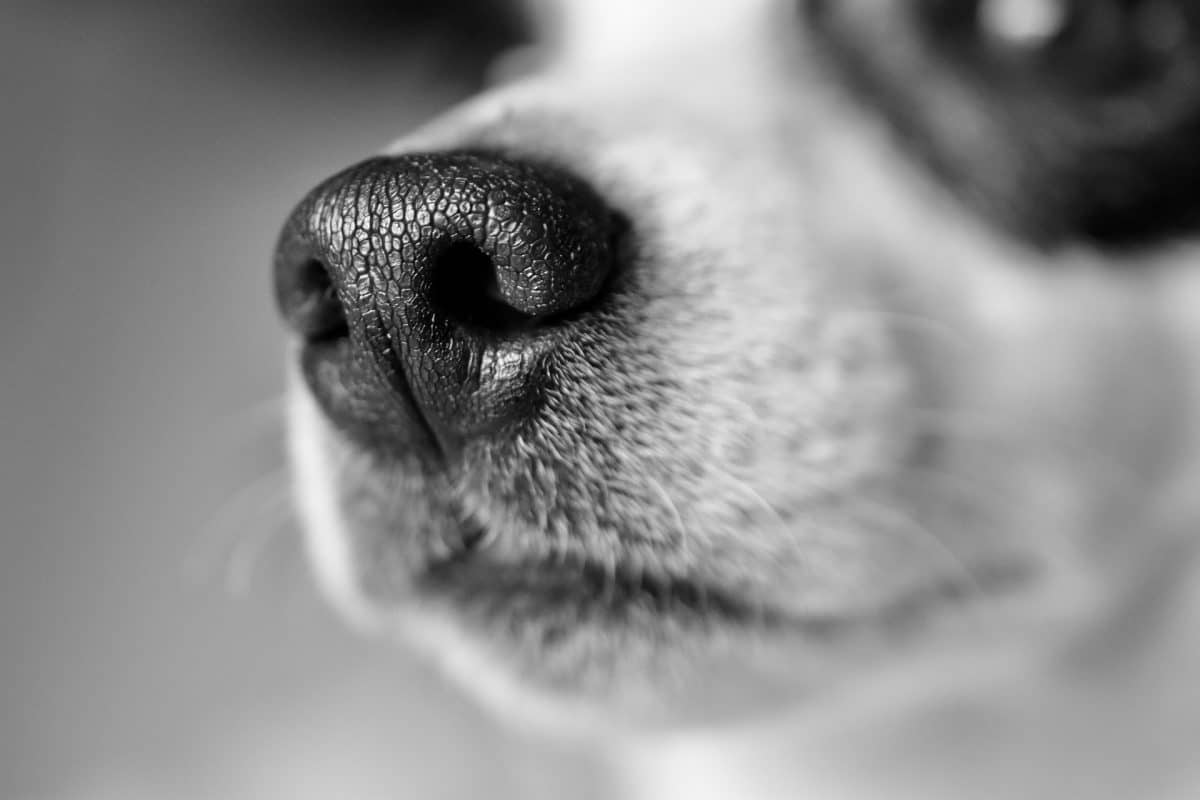
Dog whiskers, also known as "whiskers," are a fundamental orientation tool for them. They fulfill a complementary function of the senses of the smell and touch, providing them with important information about their environment.
These are thick and long hairs located around the muzzle, which have great sensitivity. Very common in mammals, they develop at an early age, and help them develop their exploration skills. Therefore, we should never cut them.
What are dog whiskers for?

Whiskers are something like the tips of our fingers. Extremely sensitive, they easily react to drafts. When the air moves these hairs vibrate, and through these vibrations, dogs are able to detect the presence, size and shape of nearby objects. In this way, they can react quickly to possible dangers.
These hairs they also allow them to measure spaces, being able to determine if they are in a narrow place without using the view. They also help protect their eyes, as any contact with the whiskers causes them to blink immediately.
Not only are the mustache hairs that provide information to the animal, but also those found in the lips, chins, ears and eyebrows, with each area with its own peculiarities.
Other functions of the whiskers of dogs
In addition to the functions that we have seen, the truth is that whiskers are a very important part for dogs. And they are because they have functions that help your pet to relate to its environment and feel safe.
But what other functions do they have apart from those described above? Well, take note of the following:
They serve to guide you
Although it seems impossible to you that something so small and finite can help them orient themselves, the truth is that it is so. Through those hairs, what they do is create in a head a kind of map that helps them to know where they are, where there is danger, where the objects ... In other words, create a map to move around the places. Not only that, but also with whiskers you can calculate proportions of objects, distances ...
Hence the importance they have, because it allows them to move more safely, be it through a house, a garden, the outdoors ...
With them they measure the temperature of the environment
What would you not have said? Yes, they are able to know what the temperature is without needing any device to carry out the measurement. And that they do it through air currents.
Therefore, when they are cut, they can have problems because they do not know the temperature well (and they can get sick).
They serve as protection
Also, because these they are usually longer and warn them if they get too close to objects, causing them to move away from them. At the same time, they are also a barrier since, if they detect something, they allow them a little more time to react and move away.
Why do they fall?
They also help us to obtain information on the health of the dog, since they are often used for dermatological tests. The most common diseases in whiskers are scabies, burns, pyoderma hair follicle, trauma and dysplasia of the hair follicle.
Other causes are:
Loss due to hormonal disorders
The fall of the mustache is not always associated with the natural moult of this, there are in fact diseases that make the loss abundant and very evident, as is the case with hormonal disorders.
One of the characteristics of this pathology is when the fall is located in certain areas, for example, loss can be on both sides, symmetrical and not itchy.
Given these symptoms, it is best to go to your veterinarian, since the necessary studies must be applied to determine the origin that may be between: the Cushing's syndrome or hypothyroidism. Once the cause is determined, we proceed with the corresponding treatment.
There may be other causes associated with allergies caused by the presence of pollens, fleas, food or drugs. In these cases the type of treatment applied is linked to the allergen agent that is affecting the dog.
Fall due to skin diseases
There are several diseases that can affect your pet's hair, skin and whiskers, some of them give way to the fall in small quantities or in an exaggerated way. We will mention those that make the loss very considerable:
Dermatitis
Dermatitis It is a disease that is the product of the reaction of the dog's body against allergens mainly, and sometimes is of genetic origin. It is characterized by an inflammatory process of the skin that is accompanied by itching.
Among the different types that exist, the most common is atopic dermatitis. Other symptoms associated with this or another type are reddening of the skin and excessive itching.
Tub
This is manifested by the fall of the whiskers, which leave the area completely devoid of. The origin is a fungus or canine ringworm that produces circular lesions in which the loss is total. It is It is important that he is given the appropriate treatment indicated by the veterinarian.
Canine pyoderma
This takes place when the dog's skin is affected by a disease that causes its defenses to drop, there they take advantage of the bacteria to infect your pet, generating in addition to the shedding of the coat, the fall of whiskers, wounds, excessive itching, bad smell and even ulcers in the most serious cases.
Treatment is usually quite extensive and with antibiotics prescribed by the specialist, so it is necessary to follow it to the letter.
Scabies
Of the different types of scabies, there are two that are the most common: sarcoptic mange and demodectic mangeBoth have their origin in the presence of mites that settle in the body of your pet.
The symptoms consist of sectorized loss of the coat, drooping of whiskers, reddening of the skin, itching and in some cases the loss of the coat is total. These they differ from each other according to the type of mite that is installed in the animal.
On the other hand the mite "Sarcoptes scabiei”Is the cause of sarcoptic mange and is usually extremely contagious, the good news is that a new outbreak can be cured and prevented with the right measures.
Dogs with "special" whiskers
All dogs have whiskers. It is something that, as we have seen, perfectly fulfills the functions reserved for this part of your body. However, there are breeds of dogs that are "special." And not because they are bigger, smaller or have characteristics that make them stand out. But because they have something that everyone has, but theirs is special.
We are talking about dogs that have whiskers. Literally. And yes, believe it or not, there are quite a few races like that. They are characterized by having elongated vibrissae that gives them an original and curious appearance, so much so that it draws a lot of attention.
And what breeds of dog have it? Well, here we list them all.
- Irish wolfhound
- dandie dinmont terrier
- Portuguese spaniel
- Tibetan terrier
- Affenpinscher dog
- Pomsky dog
- border collie
- Havanese bichon
- Bichon bolognese
- Belgian griffon
- Brussels Griffon
- West Highland White Terrier
- Schnauzer (dwarf and giant)
- cairn terrier
- Catalan shepherd
- Long haired collie
- Russian black terrier
- Long-haired Pyrenean Sheepdog
- airedale terrier
- Norfolk Terrier
- Pekingese dog
- Maltese bichon
- Bearded Collie
- Bergamasco shepherd
- Yorkshire Terrier
- skye terrier
- Plains Polanco Shepherd Dog
- Soft coated wheaten irish terrier
- Australian terrier
- Little lion dog
- Shih Tzu
- scottie terrier
- Fox terrier
- Coton de Tulear
- Lhasa Apso
- bobtail
Can you cut a dog's whiskers?
It is not the first time I have heard or read that a person has trimmed or trimmed their dog's whiskers, supposedly to make it more handsome. But the reality is that no, they cannot be cut, since as we have commented, they serve you to obtain information about your environment. In addition, dogs are beautiful as they are: they do not have to be changed.
Why not cut a dog's whiskers?
Certainly the dog's whiskers can grow back and are in fact periodically renewed Like the rest of the fur, however, it is not a wise decision to cut them because it seems to you that it looks more beautiful that way.
It turns out that specifically these hairs have much deeper roots than the rest, they are longer and visibly thicker (at least twice) and all these characteristics have a purpose, which is to allow them to perceive everything around them.
The fact that the roots are deeper, allows them to send messages to the brain regarding the objects, location, distance or size.
When you decide to cut his whiskers, you are surely limiting his natural ability to hunt, play and in general be alert to certain changes that happen around him. It's like temporarily taking away his sixth sense.
For example, the dog can determine the dimensions and morphology of a certain object, or how small a space is just by perceiving the air current in its whiskers.
These also provide protection, as is the case with those that are located in the upper part of the eye.
In definitive, whiskers are part of the dog's senses And for this reason they should not be eliminated because although they grow back, you are going to leave your faithful companion a bit unprotected since they will not be able to collect information about what is happening around them for a while.
Do dogs' whiskers grow back?
If you have adopted a dog that has cut whiskers, or if you have cut them yourself, you can rest assured that they do grow back. Tactile hairs or vibrissae are born in the same way as normal hair, that is to say, the hair bulb is formed first and from then on the external part emerges, which are the hairs that we will end up seeing on your face.
The most interesting thing about this is that, throughout the process, has been fed thanks to the blood vessels connected to the hair bulb. Said bulb, being under the skin, remains intact after the haircut, so it can continue to grow without problems.
My dog's whiskers fall out, is it normal?
If your dog's whiskers fall out in principle you do not have to be alarmed. Whiskers, like hairs that they are, it is normal for them to fall out after a while. In this situation, after a few days they will come out again. However,
If the animal has other symptoms, such as loss of appetite and / or weight, apathy, mood swings, or any other that makes us suspicious, we will have to take it to the vet as soon as possible. since it could be that his health was failing and follow all the directions you tell us.
Do dogs shed their whiskers?
The whiskers, like the rest of the hair, they usually fall off on their own over timeThis is a process that should not alarm you because new whiskers will be born in a few days.
Means that dogs shed their whiskers from time to time; However, it is necessary to pay attention that at the time of the loss of vibrissae no other symptoms associated with any pathology are present, if so, the right thing to do is take him to the vet.
Do the dog's whiskers turn white?
Another question that you can ask yourself about dog whiskers, or that you may have seen in your pet and want to know if it is natural or not, is the fact that they turn gray. In other words, that with age they turn white.
As you know, when they reach a certain age, usually between seven or eight years old, dogs begin to present gray hair on their fur. The first place where they appear is usually in the area of the muzzle, then spreading throughout the face, especially in the eyebrows, the eye area ... Before that age, experts see in this a symptom of a very dangerous disease: stress.
But focusing on white whiskers, you should know that, just as their hair grays, so can their whiskers. This is due to DNA begins to fail, with age, in the creation of melanocytes, that is, in the cells that are responsible for coloring the hair. And as a result, gray hair begins to appear, including it in the whiskers.
For this reason, when a certain age arrives, it is common for these vibrissae to turn another color, and even transparent, not being distinguished by the naked eye. What's more, they can become more fragile.
Do they need special care? Yes and no. It is not an easy answer since, taking into account the functions of whiskers, over the years they also fail and do not provide the same information as before. In addition, they do not grow so fast when they are older, so it is necessary to avoid cutting them so that they are not deprived of that important part for him.
Can I touch the dog's whiskers?
If you have children, or simply if you like to pet your dog, at some point you will have touched his whiskers, willingly or unwillingly, right?
What has your pet's reaction been? You should know that whiskers are a very sensitive and delicate area, and that many dogs do not tolerate being touched because it makes them feel uncomfortable. In fact, you can even make them feel annoyed, or that they move away from you and do not want you to approach so they do not go through that situation.
Therefore, as far as possible, we recommend that, as far as possible, do not touch them, much less if it is a dog you do not know, because it may end up attacking (or at least making a feint at it) .
Do you know that your dog has whiskers in many areas of the face?

Maybe you don't know it, but you should know that your dog not only has whiskers in the mouth area, you can also find them in other parts, such as for example in the area of the muzzle, on the lips and chin, on the jaw and on the eyebrows.
These differ from the usual fur in that they are harder than hair, and also longer than these, because they help them as a sixth sense to protect their most delicate areas (the mouth, the eyes ...).
We hope it has been useful to you.

I have a small Frensh Poddle, and the hairdresser removes his whiskers. What do you advise me?
That you do not do it more, it is logical. Tell the groomers not to keep trimming the dogs' whiskers.
I cut his mustache by mistake and every time he goes to the park he comes back with a stinky smell
Ale, most likely that smell is for another reason. It was the same with one of my pets until I discovered that he liked to rub himself with remains of rotten things, fish remains and even those…. She is an adorable dog, but in tastes and senses, they are very different from us. With my other two puppies I never had this problem.